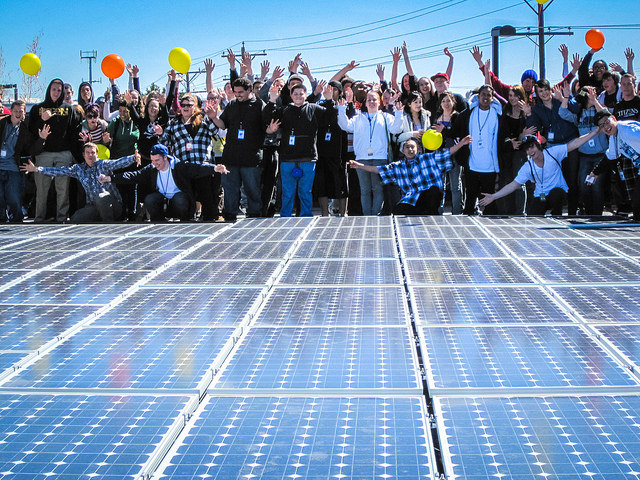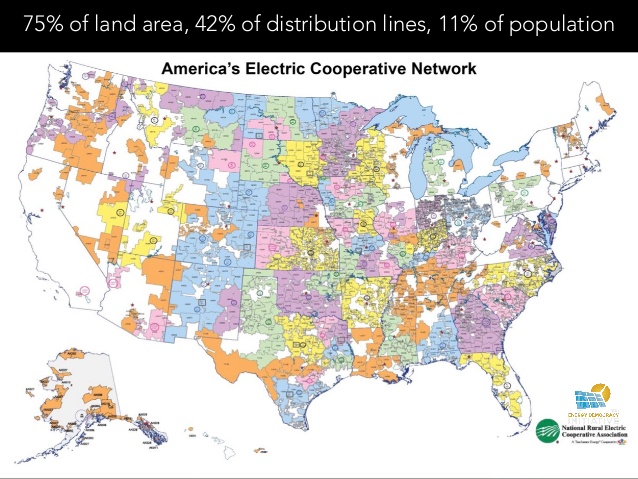This week in Energy Democracy news:
An Atlantic reporter explores how (easily) solar panels are installed, Madison adopts a carbon emissions plan, and Boulder city officials discuss municipalization with Xcel Energy.
Featured Stories
Madison adopts plan to cut carbon emissions 80 percent by 2050 by Kari Lydersen, Midwest Energy News
Two decades of solar pioneers in Sacramento – Episode 27 of Local Energy Rules Podcast by John Farrell, CleanTechnica
Amid industry shift, keen national interest in Boulder-Xcel settlement talks by Alex Burness, Boulder Daily Camera
Municipalization might not be Minneapolis’ most effective tool for accelerating clean energy goals, the petitioners argued, but the threat of it would give the city negotiating leverage when Xcel’s franchise agreement expired in 2014.
“We talked to a lot of people, saying, ‘Look at this opportunity we have,’ and ‘Look at what they’re doing in Boulder, Colorado,'” Farrell said last week. “This stuff is obscure, but we wanted to highlight the key issue here: We should have choice.”
What I learned installing solar panels by Julian Spector, CityLab
Why energy democracy offers a faster approach to clean energy by John Farrell, CleanTechnica
Energy Democracy News in the States
Arizona
New APS rate case seeks mandatory demand charges by Julia Pyper, GreenTech Media
Arizona Public Service filed a general rate case today, which the utility says will create a more sustainable grid system by reforming the residential rate structure and eliminating the cost shift between solar and non-solar customers.
The plan seeks to introduce mandatory demand charges on all of APS’ residential and small business customers. The proposal also calls for shortening and shifting on-peak hours from the existing on-peak window of 12 p.m. – 7 p.m., to 3 p.m. – 8 p.m. when APS customers are using the most energy.
Arizona Public Service attempts to weaken net metering – again by Christian Roselund, PV-Magazine
APS rate case sparks concern beyond mandatory demand charge proposal by Herman K. Trabish, UtilityDive
APS, SolarCity fail to reach agreement over net metering by Ryan Randazzo, AZ Central
California
Californian just saved $192 million thanks to efficiency and rooftop solar by Julia Pyper, GreenTech Media
Report pushes ‘solar-plus-storage’ by Rob Nikolewski, San Diego Union Tribune
California removes barrier to distributed generation participating in power market by William Pentland, Forbes
Colorado
Amid industry shift, keen national interest in Boulder-Xcel settlement talks by Alex Burness, Boulder Daily Camera
Municipalization might not be Minneapolis’ most effective tool for accelerating clean energy goals, the petitioners argued, but the threat of it would give the city negotiating leverage when Xcel’s franchise agreement expired in 2014.
“We talked to a lot of people, saying, ‘Look at this opportunity we have,’ and ‘Look at what they’re doing in Boulder, Colorado,'” Farrell said last week. “This stuff is obscure, but we wanted to highlight the key issue here: We should have choice.”
Georgia
Q&A: How a Georgia Republican pushed his state forward on solar by Gillian Neimark, Southeastern Energy News
Hawaii
Still no deal between Hawaii utility and Florida’s NextEra. Local pressure mounts by Ken Silverstein, Environmental Leader
Hawaiian Electric files with state regulators to begin new pursuit of utility-scale renewables by Herman K. Trabish, UtilityDive
The Hawaiian Electric Co. (HECO) asked the Hawaii Public Utilities Commission (HPUC) to open a docket to approve its issuance of a formal Request for Proposals (RFP) for renewable energy projects on Oahu. This is, HECO said, an early step toward meeting the state’s 100% renewables by 2045 mandate.
Iowa
Stymied by its utility, Iowa college looks at solar backed by storage by Karen Uhlenhuth, Midwest Energy News
Luther College, in Decorah, Iowa, set a goal in 2012 of generating 50 percent of its power from renewables in 2015, 70 percent by 2020, and attaining carbon neutrality by 2030. It invested heavily in energy efficiency improvements, and built a 1.6-megawatt wind turbine and installed two solar arrays with a total 1.1 megawatts of capacity.
Getting to carbon neutral may be difficult because of limits on net metering in Iowa.
Solar energy sector facing challenges in Iowa by George C. Ford, The Gazette
Maine
Solar power providers slowly expand without support from Augusta by Tory Ryden, WLBZ-2
Massachusetts
Deerfield solar array details nailed down by Andy Castillo, The Recorder
Michigan
State senate energy bills threaten many, starting with solar workers by Jim Dolzo, Crain’s Detroit Business
But these bills — essentially utility wish-lists — also attack the little guys: the hundreds of Michigan workers who, using the state’s current net metering law, wire up homes and businesses with solar panels. SB 438 will put many of them out of business and nip Michigan’s nascent rooftop solar boom by slashing what a utility must pay a solar customer for the extra electricity his panels put on the grid.
Minnesota
$2.1 million campus microgrid addresses sustainability goals outlined by Pope Francis and other quick news by Cara Gorman, Microgrid Knowledge
Minnesota community’s energy focus gives it edge in national competition by Frank Jossi, Midwest Energy News
Minnesota regulators halt rural co-ops’ fixed charges for solar by Frank Jossi, Midwest Energy News
Finding power in the local: How Grand Marais is tapping green technologies to reach for sustainability by Stephanie Hemphill, MinnPost
Montana
Net metering gaining popularity in Montana by Tom Lutey, Billings Gazette
PSC, utilities debate fair price for renewable energy by Corin Cates-Carney, Montana Public Radio
Nebraska
Solar power on the rise in Nebraska by Fred Knapp, NET Nebraska
Nevada
Where Sandoval’s energy task force stands on renewables, solar by Daniel Rothberg, Las Vegas Sun Review
Who’s subsidizing whom? by Dennis Myers, Reno News Review
Two studies tout net metering benefits, but debate continues by Julia Ritchey, KUNR
New York
Why isn’t solar energy spreading faster in NYC? by Miranda Katz, Gothamist
Town of Ulster reviews proposed solar installation, equipment regulations by William J. Kemble, Daily Freeman
Groups call on N.Y. regulators to ‘put community solar back on track’ by Solar Industry Magazine
North Carolina
Community solar benefiting co-op members in North Carolina by Rhiannon Fionn, Southeast Energy News
North Dakota
Cass County Electric breaks ground for largest solar array in North Dakota by Helmut Schmidt, InForum
Ohio
Group pursuing citywide push for solar power by Julie McClure, The Republic
Annual Ohio tour reaches out to state lawmakers on clean energy by Kathiann M. Kowalski, Midwest Energy News
Ohio’s attempt at power plant bailouts should alarm conservatives by Devin Hartman and Dick Munson, Real Clear Energy
The deals, brought forth by American Electric Power (AEP) and FirstEnergy Corp., would have resulted in higher bills, environmental damage, stifled innovation, diminished value for customer choice and less competitive markets for Ohio. Unfortunately, the rationale behind the Ohio decision still threatens to turn this kind of irresponsible, anti-competitive plan into a broader movement. This should outrage conservatives.
Over the past decade, cheap natural gas drove some of AEP and FirstEnergy’s coal and nuclear power plants into the red. The companies sensed an opportunity to seek subsidies for these plants through mandatory ratepayer charges, chanting the motto of “rate stability” and appealing to keep in-state power plants online. The companies received their bailouts in an alarmingly unanimous vote by the Public Utilities Commission of Ohio.
Oregon
Battles spread over popular solar buyback plans by Jon Frandsen, Bend Bulletin
Texas
Solar will replace nearly all retiring coal in Texas by Katherine Tweed, GreenTech Media
Bumper crop of ‘community solar’ projects coming to Texas this summer by Sergio Chapa, Houston Business Journal
Wisconsin
Energy fair returns to Custer by Michael Casper, Scene
Board discusses solar project, referendum by Kayla Burns, Republican Journal
Energy Fair returns for 27th year by Nathan Vine, Stevens Point Journal
Madison adopts plan to cut carbon emissions 80 percent by 2050 by Kari Lydersen, Midwest Energy News
Mitch Brey, campaign organizer of the group RePower Madison, described the planas an important step in creating clean energy policies and programs in the city. He noted that some aspects of the plan are already enshrined in city or state policy, but the new plan calls for new resources or action to help fulfill those goals.
Along with the aforementioned targets, the plan calls for establishing a city-wide Property Assessed Clean Energy (PACE) program, making it easier for property owners to finance energy improvements; developing an inventory of all the city-owned property suitable for rooftop solar; and ensuring implementation of a benchmarking resolution passed last year, which would document buildings’ current energy consumption to chart future improvements.
Nationwide Energy Democracy News
Wind and solar could meet nearly all Midwest energy needs by 2050, researcher says by Andy Balaskovitz, Midwest Energy News
2016 is a breakthrough year for solar by Rona Fried, The Hill
Rate design roundup: demand charges vs. time-based rates by Herman K. Trabish, Utility Dive
What I learned installing solar panels by Julian Spector, CityLab
Community solar programs can reach millions of people – if utilities design and market them right by Silvio Maracacci, GreenTech Media
Why the public, especially conservatives, should thank net metering by James Tong and Alison Mackey, GreenTech Media
To criticize NEM for creating inefficiencies would be like blaming a scale for making a person overweight. NEM has helped reveal long-term deficiencies in the regulatory model: poor pricing mechanisms, incentives to overspend, and rampant cross-subsidization, to name a few. Some states, including Hawaii, Minnesota and New York, are looking to revamp their utility models, thanks in part to NEM discussions.
Furthermore, NEM customers are pioneering a more efficient grid. Rooftop solar heralds a series of customer-sited technologies — collectively known as distributed energy resources (DERs) — that promise to make the grid more robust, cleaner and less costly. DERs, including smart thermostats, electric vehicles, energy storage, and automated appliances, can optimize consumption and supply depending on both the needs of users and the grid. They can create new business opportunities, like the peer-to-peer sharing models of Uber and Airbnb. They can also minimize the role of the public sector in the power industry. When customers invest in DERs, they use private capital, not utility capital that the public — that is, ratepayers — must ultimately repay.
With solar prices so low, people are buying systems, not leasing them by Sustainable Business
This article originally published at ilsr.org. Sign-up for our newsletter updates and follow us on Facebook and Twitter.





